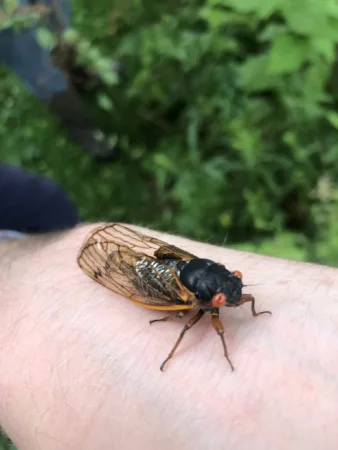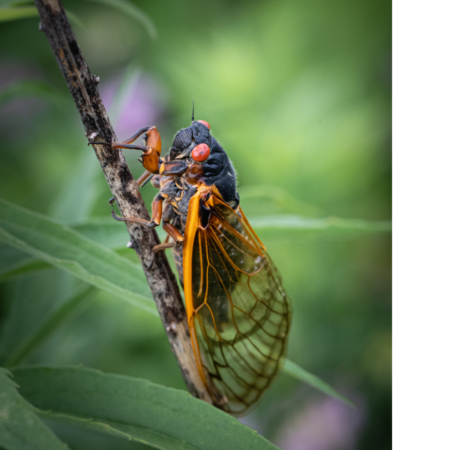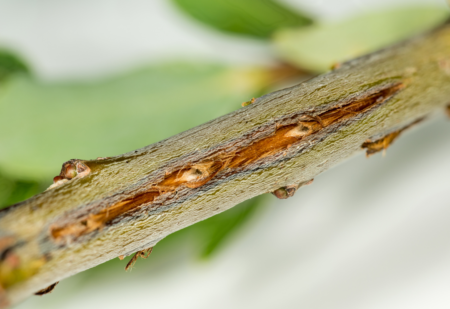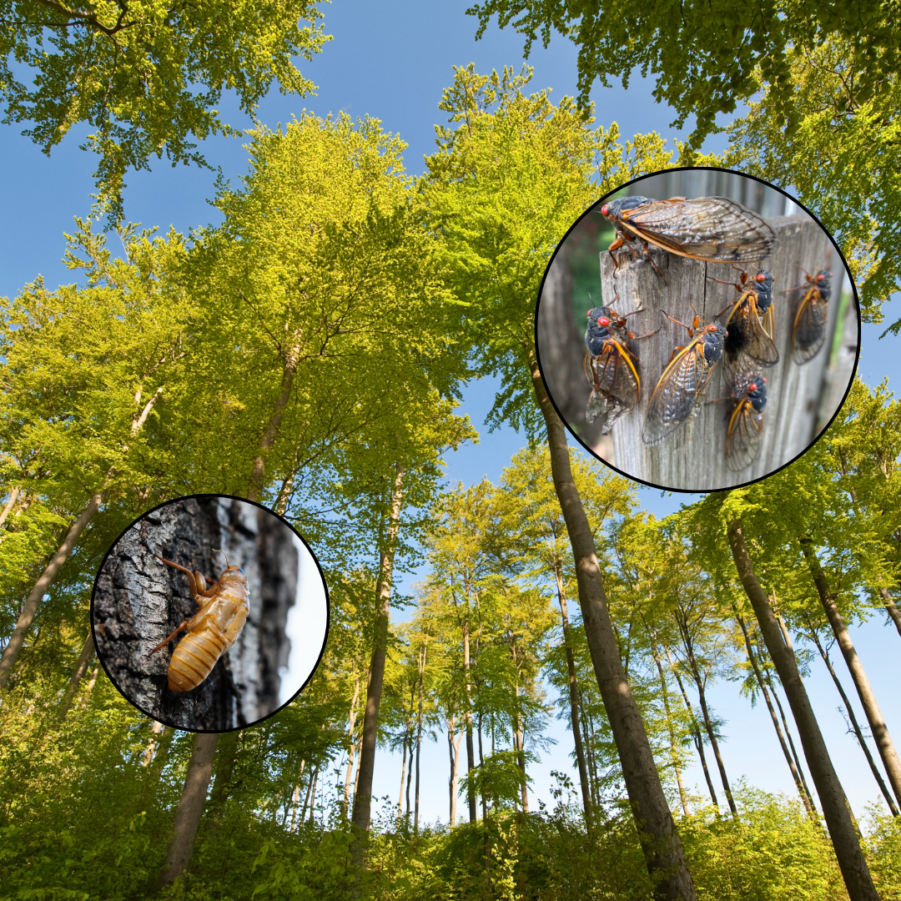You may have heard rumors that 2024 will be a big year for the cicada. News outlets and magazines are putting out panicked headlines about an “insect apocalypse”. As if we didn’t have enough to worry about in 2024! In this Biologist Ruins Everything post, let’s get to the bottom of these claims and learn about the cicadas in question.
The specific group that folks are worried about consists of several species belonging to the genus Magicicada. Folks more often call them by their common name, periodical cicadas. If you’re looking for a quick run-down on cicadas in general, check out my post 14 wild cicada facts!
What are periodical cicadas?

Periodical cicadas are a subgroup of the superfamily Cicadoidea, part of the order of Hemipteran insects. Periodical cicadas are native to North America, and found on no other continent. Although some other cicada species are synchronous breeders (for example, the awesome World Cup Cicada Chremistica ribhoi), they do not take it to the scale that periodical cicadas do.
Check out this guide to common insect orders to learn more about the insect groups you’re most likely to encounter in the outdoors!
While all cicadas spend their juvenile or larval stage underground sucking on plant roots and emerge only as adults to breeds, periodical cicadas do this with a bit of a twist. That is, they come out all at once! So, rather than a steady stream of individuals emerging every year as in most cicada species, periodical cicadas surface in gigantic numbers. However, they only do so every once in a while. Literal billions of these insects emerge to find mates, breed, and die shortly thereafter on a predictable cycle. Like other species of cicada, they sing loudly after emerging, and use their piercing mouthparts to drink fluids from trees.
The end result of this is that individual groups of in-synch cicadas (known as a brood) typically breed only with each other. Although there may be other broods within a species, their massive emergences might not line up. Thus, even if they occupy the same areas and feed on the same trees as larvae, they will unlikely every meet as adults!
What’s so special about periodical cicadas?

I have had a lot of readers asking me what is so special about periodical cicadas. Don’t cicadas come out every year? It’s absolutely true that most cicada species are annual. Although they may also take several years to mature, they do not synchronize their emergences or the laying of their eggs. Because of this, some individuals of annual species come out and sing every year, even though they may not all be the same age.
Periodical cicadas, however, can’t really afford this sort of “wiggle room”. They time their emergences together for a reason! Their major defense against predators is their sheer numbers, and if a young cicada emerges too early or too late, it’s in deep trouble. By coming out apart from the rest of its brood, the cicada has only a slim chance of finding a mate, and will be defenseless against predators. While there is safety in numbers, a lone periodical cicada is nearly helpless.
How often do periodical cicadas come out?

Different species of periodical cicadas come out at different intervals. Some are 17-year cicadas, while others are 13-year. In each case, they spend that many years underground before coming to the surface! To make things more complicated, as I mentioned before different broods are not lined up with each other. So there are different groups of periodical cicadas from different species, some emerging at 17-year intervals, and others at 13-year intervals.
Even though an individual brood’s emergence is predictable, a mass emergence from any brood in a given year seems random and chaotic. This prevents predators from timing their reproductive cycles to take advantage of the cicadas and making their overwhelming numbers no longer an advantage.
What does 2024 mean for the periodical cicada?

While the timing of periodical cicadas means that you might not see any at all in most years, there is an emergence somewhere once every couple of years. Furthermore, you might very rarely have the timing of one or more brood line up. In that case you can expect a pretty massive emergence as both huge broods emerge at the same time!
That’s precisely what is predicted to happen in 2024.
Why is 2024 a big cicada year?
Two major periodical cicada broods, Brood 19 (or to use the conventional Roman numerals, XIX) and Brood 13 (XIII) will emerge in 2024.
Brood 19 is on a 13-year life cycle and consists of two species, Magicicada neotredecim and M. tredecim. The cicadas that will emerge from that brood this year hatched back in 2011! This brood, also known as the Great Southern brood, will cover a big swath of the American Southeast and southern Midwest.
Brood 13 is on a 17-year life cycle, and will come out further North in states like Wisconsin, Indiana, Michigan, Iowa, and Illinois. These cicadas hatched back in 2007, and includes the same three species as brood 10 (X) which I witnessed during their 2021 emergence. The species are M. cassini, M. septendecim, and M. septendecula.
What do periodical cicadas eat?
Like other cicadas, periodical cicadas feed on plant juices. Specifically, they feed on xylem, which is the nutrient-poor liquid that travels from a plants roots to its leaves. They use their piercing, straw-like mouth parts to pierce the bark of their host tree and suck these juices from its vascular system. Since their bites are relatively minor and what they feed on is mostly water, cicadas don’t do much damage to trees by feeding.
Do cicadas destroy crops?

I have heard from many concerned readers about fears that cicadas will harm crops. Importantly, adult cicadas only feed on trees, and will not damage herbaceous plants. Crops like soy, wheat, and many vegetables are not in any danger. The greatest potential damage that cicadas can do to crops would be to tree crops. However, this would not be due to feeding, but due to the way that females lay their eggs.
Briefly, they use a sharp organ on their abdomen to cut a slit in the tips of young branches, and place an egg inside. Eventually, the branch-tip dies and falls to the ground, at which point the larval cicada hatches and burrows underground. In this way, female cicadas can cause some damage to crops that grow on trees, for example apples or peaches. However, scientific studies indicate that this damage is minimal and does not seem to affect fruit crops.
The bottom line? Don’t worry about your farms and gardens. Instead, try and enjoy the show. After all, it’s been over 200 years since we saw these two broods come out at once!
Thanks for reading about cicada year 2024!
Are you going to see some massive bug action in the 2024 cicada year? Share with us in the comments! If you enjoyed this post, please support the blog by sharing this post and connecting with us on social media. If you have an idea for post you’d like to see on Gulo in Nature, get in touch using the Contact Page. Thank you for reading!

